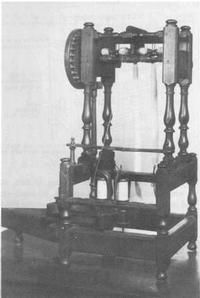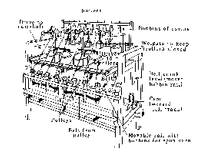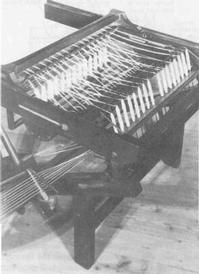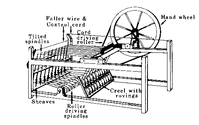


Chapter 5
I 1788 - State Of The Art In Textile Technology
II Australian Textiles - The Early Days
III Australian Textiles - The 20th Century
IV Australian Textiles - To Date
V Acknowledgements
References
Index
Search
Help
Contact us

Richard Arkwright used such principles in his spinning machine, subsequently known as the 'water-frame' (1769). At first, this machine was horse driven, but by 1775 he had improved the machine considerably and converted it to water power. Rovings were wound on bobbins at the top rear of the machine (Figs. 4 and 5), and yarn was drawn from them by four drawing rollers of progressive speeds. The threads were led down to the front of the machine to vertical spindles with metal flyers, which were driven by a belt from the main wheel. The yarn bobbins were marked on slotted projections fixed to a movable wooden rail behind the spindles, and the metal flyers had eyelets at the end of one leg to lead the thread. In motion, the bobbin rail was raised and lowered by the action of a cam, to distribute the yarn evenly. The principles involved in this machine form the basis for today's worsted spinning system.


While Arkwright was capitalising on his invention, James Hargreaves was working on his famous invention -the spinning jenny. This machine (Figs 6 and 7) consisted of a horizontal frame mounting a large hand-wheel at the spinner's end. By means of a cord, the wheel drove a long horizontal cylinder placed low at the other end of the frame. In the centre of the frame was the creel, carrying stationary spindles on which the rovings were wound. A corresponding number of rotary spindles were mounted at the far end of the spinning and winding yarn, and these were driven by cords from the cylinder. A movable carriage with wheels could be moved to and fro on the top rails of the frame.


The operation consisted of a complicated series of steps of feeding, drawing back the carriage to draft the roving whilst inserting twist by means of the hand wheel, adding further twist to the yarn, and then winding the yarn on the spindle whilst synchronously pushing the carriage forward.
After the water-frame and the jenny came the mule -the invention of Samuel Crompton. The machine combined the principles of both the water frame and the jenny and produced finer yarns than the other two. In the woollen industry it was to become the major form of woollen yarn spinning for many years.
 |
Australian Academy of Technological Sciences and Engineering |  |
© 1988 Print Edition page 260, Online Edition 2000
Published by Australian Science and Technology Heritage Centre, using the Web Academic Resource Publisher
http://www.austehc.unimelb.edu.au/tia/269.html